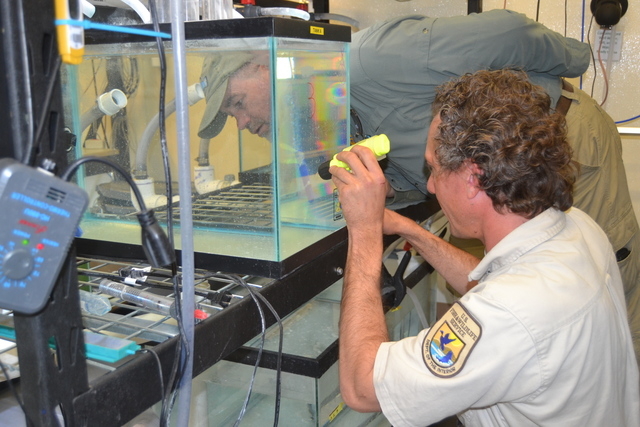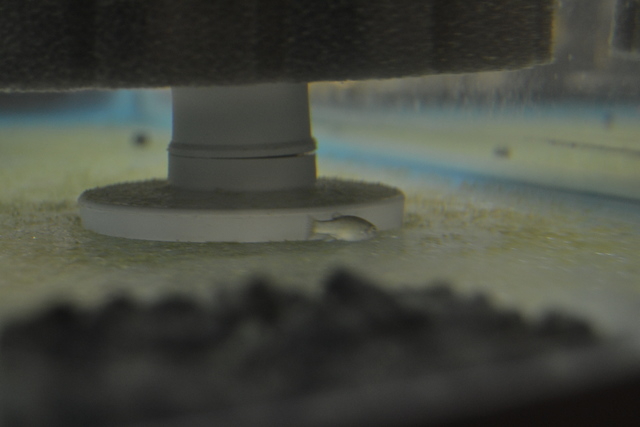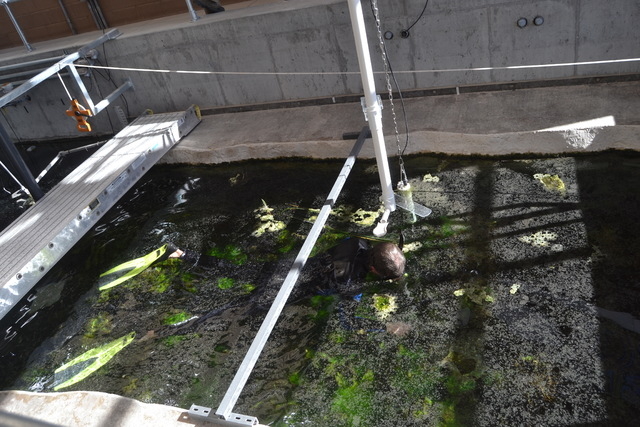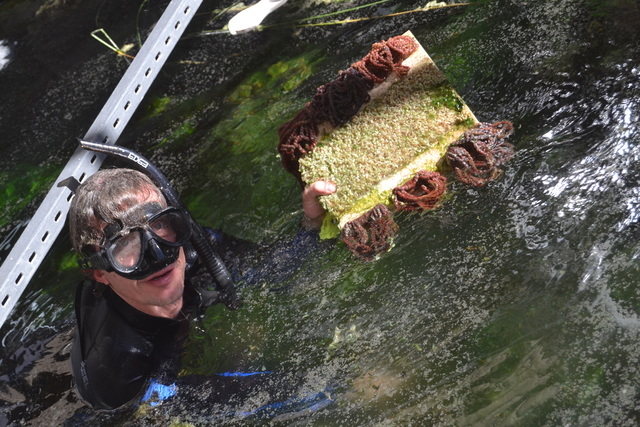PUPFISH KEEP ON SWIMMING: Devil’s Hole Pupfish teetering on edge of extinction
Millions of dollars have been spent to study and preserve an ancient fish that lives on the brink of extinction. Money continues to be spent with no expressed quantifiable goal, although biologists and aquaculturists are amassing data that they hope will have broad implications.
The fish derives its name from the Hades-like environment adjacent to Death Valley in an obscure part of the Mojave Desert in Southern Nevada - the Devil’s Hole pupfish, Cyprinodon diabolis.
Granted endangered species status in 1967, an official head count was taken five years later revealing only 550 fish remained. Though the numbers have fluctuated over the years, the most drastic reduction to the endemic species was revealed in 2013 when numbers dwindled to just 35 fish.
Living conditions are extreme, with water oxygen levels well below that of what other fish can survive. Water temperatures are equally harsh, but in alignment with the desert climate, often averaging 93 degrees Fahrenheit. The sensitive ecosystem is often rocked by seismic activity from far-reaching earthquakes.
The challenging environment has been closely replicated with the completion of the 2012 construction of a state-of-the-art high-tech facility and refuge tank.
Here, scientific advances are being made which may at some point be used in cultivating wild fish for human consumption, according to U.S. Fish and Wildlife Aquaculturist Olin Feuerbacher. The facility, which cost $4.5 million to build, is annually funded by several federal sources.
Pre-build goals of replicating, to the extent possible, a “life-boat” population of Devil’s Hole Pupfish similar in abundance and genetics as those in the wild and to conduct research which supports management of the refuge facility with the ultimate goal of conserving Devil’s Hole Pupfish and their ecosystem have been successful - so far.
However, the science isn’t pure in its replication.
Harvested eggs are inoculated against disease to increase their chances of viability. Even so, the harvested, treated eggs showed the same viability rate as the wild eggs, about 50 percent. Of that number, 90 percent of the fish make it to adulthood. That discovery, biologists said, will allow them to be less invasive in future repopulation and study efforts. They no longer have to remove fish from Devil’s Hole as future study can be done with transplanted eggs.
Eggs are harvested with the use of a “incubating mat,” a small piece of standard carpet. The eggs are then placed in sterile age-staggered tanks in the facility’s propagation room, where they are studied from hatchling though adult stages. The original 29 refuge tank hatchlings, harvested from eggs, have been reproducing on their own without intervention from the biologists, Feuerbacher reports.
However, the refuge fish are offered other life-preserving benefits that the Devil’s Hole fish do not have — cooler, higher-oxygenated water and supplemental feed.
Devil’s Hole Pupfish are unique in the fact that they have been able to exist in an ecosystem smaller in size than most people’s living rooms, for thousands of years. Endangered species status was granted, in part, by the discovery of a massive decline in population attributed to falling water levels due to over-pumping of the aquifer for development.
The designation of Devil’s Hole and the Ash Meadows Wildlife Refuge as national conservation areas, prevented further over-pumping, and allowed water levels to rise once again. However, the fish population didn’t rise in tangent with the water. The creation of the “life-boat” population, though not an exact replica of the fish or their ecosystem, will allow the biologists opportunities for study of other species that are facing similar threats, such as those from climate change.
If left to their own devices, given the Devil’s Hole Pupfish known excessive adaptability qualities, one has to wonder whether they would have found a way to survive without human intervention. “When humans are involved, there is not necessarily enough time for evolution to occur. Evolution, he said, occurs over many generations, “Whereas humans are able to wipe out an entire species in a decade,” Feuerbacher said.
Human interference seems to be the one stumbling block to evolution. Devil’s Hole Pupfish have no known predators. Though, USFWS Senior Fish Biologist Lee Simons said that like most other fish, Devil’s Hole Pupfish are cannibalistic, if given the chance.
Simons suggested opportunistic cannibalism in the species is more likely because much of their activity happens on the shallow shelf in the natural habitat and in the replicated refuge tank.
The species has now been actively studied for the past 40 years, though only a few years at the refuge, and the population has been reproducing on its own without intervention from the biologists. That is a necessary component to strengthen the research.
Larger populations will allow for other avenues of study, by other groups. Feuerbacher said genetic testing of the inbred species is also being conducted by the University of Las Vegas, the University of Reno and other research facilities throughout the country.
The refuge tank and research facility also has technology transfer abilities, Feuerbacher said. The refuge’s computer system can be reprogrammed to replicate an inner ocean system. That, he said, has a lot of applications for commercial food culture.
“Most of the marine species that are commercially imported have never been cultured in captivity,” he said.
One of the questions Feuerbacher hopes to be able to answer through the research is how this highly adaptable fish is able to survive in an environment where just about every other species of fish would rapidly perish.
But at what expense and what reward? Feuerbacher said that is something to be balanced. To achieve that, he said, a successful ecosystem balanced with human needs for land and water while preserving everybody’s ability to utilize natural resources, must be identified.
The project is still in its infancy stage. Feuerbacher said his team is learning, but he is not certain, yet, exactly what they are learning or how that information will ultimately be applied.
One additional component needed to determine whether or not the study and preservation project will be fruitful, Feuerbacher said, is time. And, he said, “It’s going to take more effort, more imagination and some more luck.”




















